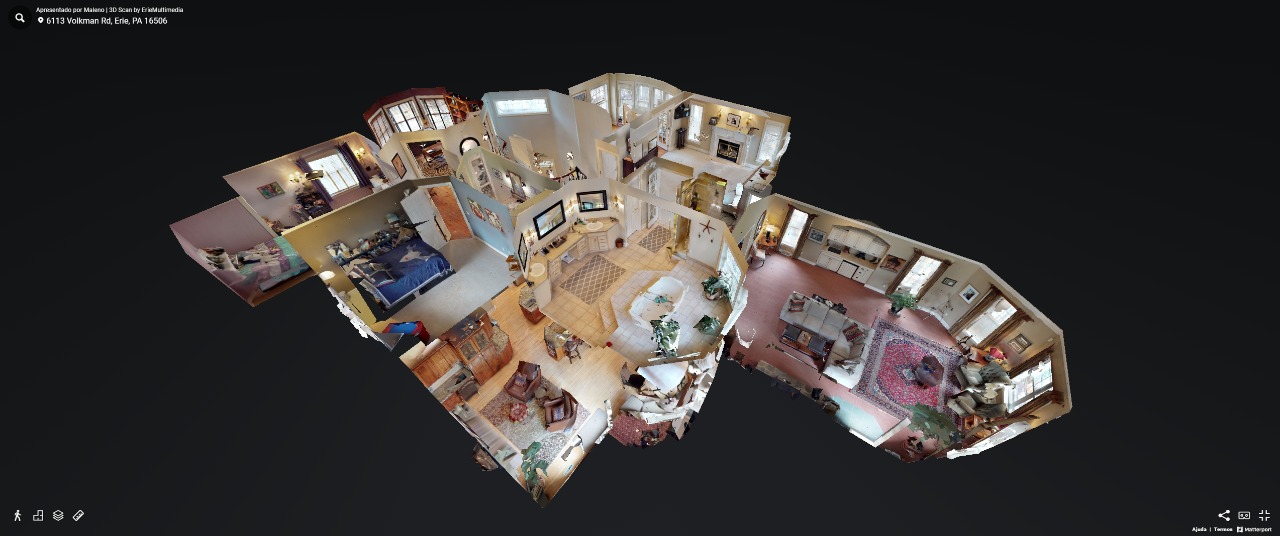 Credit: Matterport
Credit: MatterportTechnology and data revolutionise different stages of real estate activity
How digital models can help real estate managers in every building stage
October 20, 2022Real Estate
Technology for the real estate market has advanced in several areas, most notably sales and marketing. The 3D digital models and virtual tours sector enhances online sales tools and provides new facilities for sellers and customers, regardless of whether they are buyers or renters, thereby increasing sales and reducing the time for transactions.
In this sector, Matterport, founded in 2011 with offices around the world, stands out as a company focused on digitising and indexing the built world. They have a proprietary 3D data platform technology that not only creates a digital representation of the building or space, but is also designed to increase sales. With the digitisation of the real estate market, tools like this have become more essential.
Data from Grundum Imobilieren in Germany shows that buyers who visit in person after having already visited the digital model are 80% more likely to make an offer. Meanwhile, some models are even so realistic that they serve as a filter, reducing the amount of time wasted on accompanying site visits.
“In our 2020 survey, we learnt that up to 76% of home sellers regard digital tours as a necessity, and 64% would accept an offer even if the buyer only made a digital tour. So vendors are beginning to see them as a core part of agents’ listing services”, explained James Morris-Manuel, Managing Director and EMEA at Matterport.
These digital twins are changing the way buyers engage with listed buildings and helping increase sales on an interesting scale. “BeMi in Slovakia experienced a 17% increase in purchase and rental leads, and reduced time on the market by 12%, while Winkworth Estate Agents in the UK have reported a higher click-through where Matterport models have been used on listing portals”, shows Morris-Manuel with real data from his company.

The models can and have even been used to facilitate building insurance coverage and claims with customers in residential and commercial real estate, architecture, engineering and construction, and in property management, facilities management and planning.
“Capturing a digital twin right after renovation or construction gives you a pristine marketing model that you can use not only to promote the rental but also immediately after the tenancy has ended. This reduces void time since it allows you to secure a new tenant while repairs and refurbishment are taking place”, explained Morris-Manuel.
With a digital twin model, for example, it is possible to prove the condition of a property after the end of rent. With the rise of IoT, it can also help managers to have an understanding of building deterioration, plan renovations and more.
“We are seeing interesting developments in the use of IoT technology, especially to manage communal services such as shared heating, security, safety and repairs, where IoT-enabled devices and sensors can be accessed and monitored via our digital twins”, said Morris-Manuel.
The models can be used to create views showing how the property was constructed, the materials used, renovations and more. “Really useful for documenting compliance and even for avoiding drilling through essential services”, he added.
He believes that the company and its clients can learn a lot from all the data collected in more than 170 countries and extract additional commercial value from them. As an ESG manager during construction, it is critical to know how the sun, wind and other natural phenomena behave on surrounding buildings, and use them to predict the most effective way to work with natural heating, window placement, and even the most suitable materials for that type of soil and region.
“We think that property owners and managers have only just started to dip their toes into the data that a building can generate, the ways that they can exploit that data, and the applications of technology”, he concluded.
Innovation in the real estate market is one of the topics that always appears in discussions between members of the GRI Club. If you’re interested in following these and other topics, check out our upcoming events and apply for membership.
Written by Gabriela Colicigno
In this sector, Matterport, founded in 2011 with offices around the world, stands out as a company focused on digitising and indexing the built world. They have a proprietary 3D data platform technology that not only creates a digital representation of the building or space, but is also designed to increase sales. With the digitisation of the real estate market, tools like this have become more essential.
Data from Grundum Imobilieren in Germany shows that buyers who visit in person after having already visited the digital model are 80% more likely to make an offer. Meanwhile, some models are even so realistic that they serve as a filter, reducing the amount of time wasted on accompanying site visits.
“In our 2020 survey, we learnt that up to 76% of home sellers regard digital tours as a necessity, and 64% would accept an offer even if the buyer only made a digital tour. So vendors are beginning to see them as a core part of agents’ listing services”, explained James Morris-Manuel, Managing Director and EMEA at Matterport.
These digital twins are changing the way buyers engage with listed buildings and helping increase sales on an interesting scale. “BeMi in Slovakia experienced a 17% increase in purchase and rental leads, and reduced time on the market by 12%, while Winkworth Estate Agents in the UK have reported a higher click-through where Matterport models have been used on listing portals”, shows Morris-Manuel with real data from his company.

View from one of the models - Explore more
Digital twins are not only for marketing purposes
While marketing and sales are the areas that benefit most from this technology right now, it can be applied to many other parts of a building’s journey. Matterport’s idea, in fact, is to help managers with a tool that can be used from construction, through sales, renovation and building management.The models can and have even been used to facilitate building insurance coverage and claims with customers in residential and commercial real estate, architecture, engineering and construction, and in property management, facilities management and planning.
“Capturing a digital twin right after renovation or construction gives you a pristine marketing model that you can use not only to promote the rental but also immediately after the tenancy has ended. This reduces void time since it allows you to secure a new tenant while repairs and refurbishment are taking place”, explained Morris-Manuel.
With a digital twin model, for example, it is possible to prove the condition of a property after the end of rent. With the rise of IoT, it can also help managers to have an understanding of building deterioration, plan renovations and more.
“We are seeing interesting developments in the use of IoT technology, especially to manage communal services such as shared heating, security, safety and repairs, where IoT-enabled devices and sensors can be accessed and monitored via our digital twins”, said Morris-Manuel.
The models can be used to create views showing how the property was constructed, the materials used, renovations and more. “Really useful for documenting compliance and even for avoiding drilling through essential services”, he added.
The future is made of data
“Imagine connecting your Smart Energy Meter to your central heating system so that you can manage heating according to a budget. More applications are emerging all the time”, said Morris-Manuel.He believes that the company and its clients can learn a lot from all the data collected in more than 170 countries and extract additional commercial value from them. As an ESG manager during construction, it is critical to know how the sun, wind and other natural phenomena behave on surrounding buildings, and use them to predict the most effective way to work with natural heating, window placement, and even the most suitable materials for that type of soil and region.
“We think that property owners and managers have only just started to dip their toes into the data that a building can generate, the ways that they can exploit that data, and the applications of technology”, he concluded.
Innovation in the real estate market is one of the topics that always appears in discussions between members of the GRI Club. If you’re interested in following these and other topics, check out our upcoming events and apply for membership.
Written by Gabriela Colicigno







